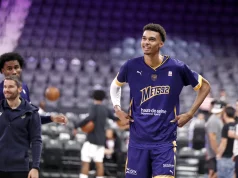
On December 3rd, during a matchup against the Oklahoma City Thunder, San Antonio Spurs forward Kyle Anderson suffered an MCL sprain and was out until Wednesday night’s matchup against the Portland Trail Blazers. That injury, combined with other injuries, had a visible effect on the Spurs’ performance over the 8 games that he missed.
Unfortunate timing was a large part of what made the injury more impactful to the team. Kawhi Leonard has played in only three games this season and he has been on a fairly restrictive minutes limit when he has played and Danny Green missed 3 games in the 8-game stretch that Anderson was out. Having those three players out, or on minutes restrictions, concurrently hurt the Spurs’ wing depth, as each of those three players can play and defend multiple positions.
This was especially apparent in first quarters of games during that 8-game stretch. The Spurs’ net rating in first quarters from the beginning of the season through December 3rd was +4.5 points per 100 possessions. From December 4th through Monday night’s game against the Los Angeles Clippers, however, the Spurs’ net rating was -15.0 points per 100 possessions during first quarters. Overall, the Spurs’ net rating fell about 2 points per 100 possessions while Anderson was out across all quarters..
The Spurs’ offense and defense has looked out of sorts at times the past of couple weeks, and the team has seemingly been getting off to slow starts in many of their games in that time frame as well. As hard as these concepts are to quantify with stats, chemistry and familiarity can have a huge effect on the performance of lineups, especially the starting unit. While Anderson may not put up 20 points each night, he has been with the Spurs long enough to know the Spurs’ system well. He doesn’t often need the ball in his hands, but he makes the right pass or play when he does have the ball. This makes him effective alongside some of the Spurs’ higher usage players.
When Leonard and Parker were out, Anderson’s court vision and ability to be a point-forward of sorts, helped enable the Spurs’ shift further to an Aldridge-centric offense. However, when both Anderson and Leonard were out, the Spurs were missing most of their small-forward depth. Of course, Rudy Gay can play the position, but aside from Gay, the Spurs found themselves playing players that are more accustomed to playing shooting guard or power forward. This also meant that the Spurs’ bench rotations had to be adjusted – an act that always has the potential to mess with certain players rhythms.
The Spurs are currently in a period of trying to find what works best for them – their best lineups, offensive sets, defensive schemes, and so on. When a large pool of players from one position are out due to or recovering from injuries and being worked back into the rotation, it can be a challenge for teams to find what works best. When Anderson returned to action on Wednesday night, that marked the first game all season in which no players on the Spurs were out due to injury (Parker and Leonard did not play, but are not currently injured). This means that the time for discovery and experimentation for this season’s Spurs squad has just begun.
All stats from NBA.com/stats.





